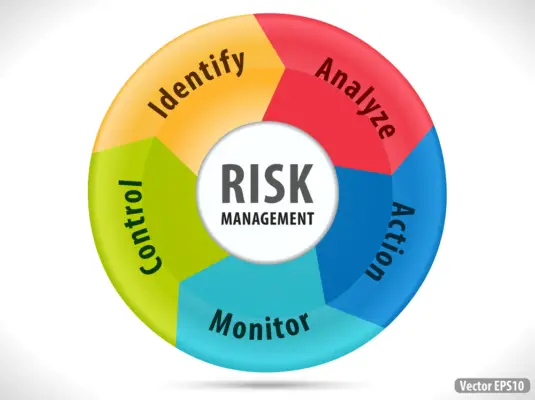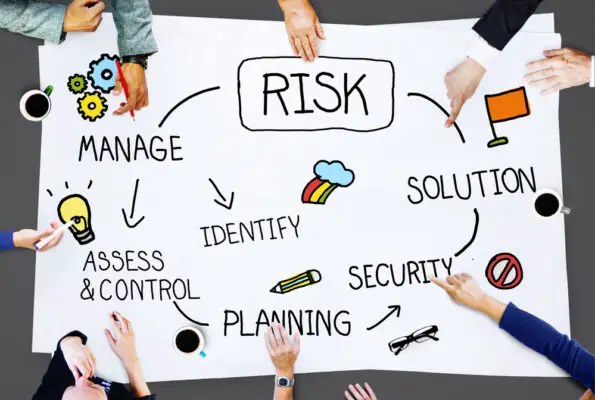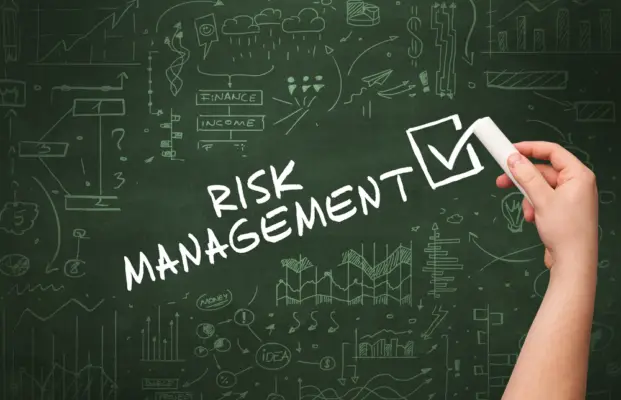A risk management plan provides a framework for organizations to identify, assess, and prioritize potential threats to their operations, finances, reputation, or stakeholders. Effective risk management requires a structured approach that integrates risk assessment and mitigation into the fabric of an organization’s culture.
Risk management is an essential aspect of any organization’s decision-making process. It involves identifying potential risks, developing strategies to mitigate those risks, and implementing a plan to monitor and manage them effectively.
It helps organizations anticipate possible risks, minimize their impact on the business if they occur and improve overall resilience.
This article provides an overview of what a risk management plan is, why it is vital for businesses across industries, how it works in practice and best practices for its implementation.

Understanding the Importance of Risk Management
The ability to identify and mitigate potential threats within an organization is essential for maintaining a secure and stable operational environment.
Risk management refers to the process of identifying, analyzing, evaluating, and prioritizing risks that may impact an organization’s operations or objectives. The purpose of risk management is to prevent or reduce the likelihood and severity of negative events that could cause harm to an organization.
To effectively manage risks, organizations must first conduct risk assessments using various risk assessment techniques such as brainstorming sessions, scenario analyses, checklists, and questionnaires. Conducting these assessments organizations will identify potential risks that may arise from internal or external factors such as natural disasters, cyberattacks, human errors, or financial losses.
Once identified, organizations can then develop strategies to mitigate these risks by implementing controls and safeguards.
Implementing effective risk management practices can bring several benefits to an organization. For instance, it allows leaders to make informed decisions based on accurate information about potential threats and their possible impacts on business continuity. Additionally, managing risks proactively helps minimize disruption caused by unexpected events while enhancing organizational resilience.
Incorporating risk management into an organization’s culture fosters a sense of accountability among employees at all levels towards mitigating potential threats before they cause significant harm.
Identifying Potential Risks
Risk identification is the process of recognizing potential risks that can impact a project or business. It involves evaluating all factors that could negatively affect operations and objectives. Risk assessment techniques are used to evaluate these hazards by estimating their likelihood and evaluating their potential impact.
Risk identification methods typically involve brainstorming sessions with stakeholders, experts, or individuals who have experience in similar projects or industries. These sessions aim to identify as many potential risks as possible, no matter how small they may appear at first glance.
The identified risks are then categorized and prioritized according to their severity and likelihood of occurrence. This allows organizations to allocate resources appropriately while focusing on critical areas that require immediate attention.
Businesses identifying potential risks early on in the planning phase can develop appropriate response plans that mitigate or eliminate them before they materialize into significant issues. Additionally, risk identification provides businesses with an opportunity to proactively manage uncertainty rather than being reactive when issues arise unexpectedly.
Risk identification is a vital component of any successful risk management plan as it enables organizations to anticipate problems before they occur and take necessary steps required for achieving long-term success without unnecessary setbacks.
Developing Risk Mitigation Strategies
There are four key methods of risk management that can be used:
– Risk avoidance
– Risk reduction
– Risk acceptance
Each approach has its own advantages and disadvantages, and selecting the appropriate method will depend on factors such as the severity of the risk, available resources, and the organization’s overall goals.
Risk Avoidance
Avoiding potential hazards is a fundamental aspect of safeguarding one’s interests and ensuring the continuity of operations. Risk avoidance techniques are employed to minimize the likelihood of risks occurring by avoiding activities or situations that pose a potential threat.
These techniques can be applied during the risk assessment phase, where risk assessment criteria are used to identify and evaluate potential risks.
Risk avoidance involves identifying and eliminating activities or situations that could lead to harm or loss. This technique is commonly used in high-risk industries such as healthcare, aviation, and construction.
For example, a hospital might avoid using certain medications or procedures that have a high risk of adverse effects on patients. Similarly, an airline might avoid flying through areas with known turbulence or adverse weather conditions.
Organizations can reduce their exposure to potential hazards and protect their assets from damage or loss through avoiding high risks.
Risk Transfer
The transfer of potential hazards to a third party, such as an insurance company, is one strategy that organizations can use to mitigate financial losses. This technique involves transferring the risk of loss from the organization to another entity in exchange for a premium payment.
Insurance is the most common form of risk transfer and provides protection against events such as property damage, liability claims, and business interruption.
Risk transfer techniques are one of many risk financing options available to organizations. Other options include self-insurance, captive insurance, and surety bonds. Self-insurance allows organizations to assume their own risks by setting aside funds or establishing reserves for potential losses.
Captive insurance involves creating a subsidiary company that provides insurance coverage exclusively for the parent company’s risks. Surety bonds are a type of guarantee provided by a third-party that ensures an organization will fulfill its contractual obligations.
Risk Reduction
In the previous subtopic, we discussed risk transfer as a method of managing risks. This involves shifting the responsibility of potential losses to another party such as an insurer or contractor.
However, transferring risk may not always be feasible or cost-effective for organizations. Hence, it is crucial to explore other methods of managing risks.
One such method is risk reduction, which involves implementing mitigation techniques that aim to minimize the likelihood and impact of potential risks. To effectively reduce risks, organizations need to conduct a thorough risk assessment that helps identify potential hazards and their possible consequences.
Based on this assessment, mitigation techniques can be developed and implemented to prevent or reduce the likelihood of these hazards occurring.
Some common mitigation techniques include improving safety protocols, conducting regular inspections and maintenance works, providing employee training programs on proper handling procedures and implementing redundancy systems in critical operations.
Reducing the likelihood and severity of potential losses through these measures, organizations can better protect their assets and reputation while also ensuring continuity in their operations when unexpected events occur.
Risk Acceptance
Another approach to dealing with potential hazards that organizations may consider is accepting the risks, which involves acknowledging the likelihood of adverse events and being prepared to absorb their consequences.
Risk acceptance is a strategy where organizations accept a certain level of risk based on their risk tolerance and appetite. An organization’s risk tolerance refers to its ability to endure or withstand risks, while its risk appetite refers to how much risk it is willing to take on in pursuit of its objectives.
Risk acceptance can be an appropriate approach for organizations when the cost of mitigating risks outweighs the benefits gained from doing so. It allows organizations to focus resources on other areas that require attention while still being prepared for any negative outcomes.
However, it also requires careful consideration as it exposes organizations to potential financial losses or reputational damage if adverse events occur.
Therefore, it is essential for organizations to determine their acceptable level of risk based on their overall objectives and ensure they have effective strategies in place should adverse events arise.
Implementing and Monitoring the Risk Management Plan
The successful implementation and monitoring of a risk management plan requires careful consideration of several key factors.
Firstly, it is essential to assign clear responsibilities for the various aspects of the plan to ensure accountability and effective execution.
Secondly, establishing effective communication channels between all relevant stakeholders is crucial in ensuring that everyone understands their role and has access to vital information.
Lastly, regular review and updating of the plan are necessary to keep it relevant and effective in mitigating potential risks.
These three factors play a critical role in ensuring that the risk management plan is effectively implemented and monitored in any organization or project.
Assigning Responsibility
Responsibility for the implementation of measures to mitigate potential hazards can be effectively allocated by assigning roles and duties to specific individuals or teams within an organization, hence ensuring that accountability is properly established.
Role clarity is essential in risk management planning because it helps to ensure that every team member understands their responsibilities and how they fit into the overall plan. By assigning clear roles, team members are more likely to take ownership of their tasks, which increases accountability.
When assigning responsibility in a risk management plan, it is also important to consider the skills and experience of individual team members. The most effective way to assign responsibilities is by selecting individuals who have relevant expertise in the area being managed.
This approach ensures that risks are identified and managed effectively because it leverages the knowledge and experience of each team member. Additionally, when assigning responsibilities, communication channels should be established between all parties involved so that everyone has a clear understanding of what needs to be done and when it needs to be done.

Establishing Communication Channels
Effective communication channels are crucial in ensuring that all team members understand their roles and responsibilities, which is essential for the successful implementation of measures to mitigate potential hazards.
Effective communication should involve stakeholders at all levels, including senior management, project managers, and operational staff.
The process of establishing communication channels involves identifying who needs to be informed about risks and how they will be communicated with. This includes developing a clear protocol for reporting incidents or near misses, as well as regular meetings or updates on progress towards risk mitigation goals.
Stakeholder involvement is critical in creating effective communication channels because it ensures that everyone has a shared understanding of what is happening and what needs to be done. Stakeholders can provide valuable feedback on the effectiveness of existing communication methods and suggest new ways to improve them. They can also help identify any potential barriers to effective communication and work collaboratively to overcome them.
Reviewing and Updating the Plan
It is crucial to periodically review and update the risk management plan in order to ensure that it remains relevant, adaptable, and effective over time. The world is constantly changing, which means that new risks may emerge while old ones might become less significant.
Therefore, it is essential to conduct regular reviews of the plan’s components, such as risk assessment criteria, mitigation strategies, communication channels, and contingency plans. Updating frequency should be determined based on the level of risk exposure and organizational changes that affect operations or objectives.
For instance, a high-risk environment like a construction site may require frequent updates due to its dynamic nature.
Stakeholder involvement is another critical aspect of reviewing and updating the risk management plan. It is important to engage all relevant stakeholders in the process of identifying potential hazards and assessing their impact on business operations or project outcomes.
This can include employees at all levels of the organization, external partners or suppliers, customers or clients who are affected by business activities or products/services offered.
Involving stakeholders in this process from an early stage onwards ensures they have a vested interest in avoiding risks which will help drive adherence to any implemented recommendations or actions arising from updated reviews.
Periodic review and updating frequency with stakeholder involvement are key components for ensuring that a risk management plan remains effective over time as well as aiding businesses adapt quickly when new challenges arise.

Integrating Risk Management into Organizational Culture
Incorporating a comprehensive understanding of potential hazards and identifying strategies to mitigate them is an essential component in establishing a culture of safety within any organization.
Employee engagement plays a crucial role in the integration of risk management into organizational culture. Employees must be aware of the importance of risk management and understand their roles in implementing it.
Encouraging open communication channels between employees and management can also help identify potential risks and develop appropriate mitigation strategies.
Change management is another critical aspect of integrating risk management into organizational culture. Resistance to change can pose significant challenges for implementing new processes, policies, or procedures related to risk management.
Management must communicate effectively with employees about why changes are necessary, how they will benefit the organization, and what steps are required for successful implementation.
Providing training and support for employees during these changes can also help alleviate resistance.
To effectively integrate risk management into organizational culture, it is important to have leadership buy-in at all levels of the organization. Leaders must lead by example by prioritizing safety over productivity or profits.
They should establish clear expectations around risk management practices, hold themselves accountable for following them, and ensure that all employees do the same. This approach fosters a culture where everyone takes ownership of identifying risks and implementing effective mitigation strategies without fear of retribution or blame.
Integrating risk management into organizational culture requires proactive efforts from leaders at all levels of an organization. They will prioritize safety above all else while encouraging employee engagement through open communication channels and change management initiatives.
These initiatives promote education/training/support among team members as needed so they understand what’s involved with managing risks effectively on behalf not just themselves but their colleagues too!
Frequently Asked Questions
How does risk management differ from crisis management?
Risk management and crisis management are two distinct concepts, albeit related. While risk management aims to identify, assess, and mitigate potential risks before they turn into crises, crisis management focuses on managing an unexpected event that has already occurred.
Crisis prevention is a crucial aspect of risk management, as it involves taking proactive measures to avoid or minimize the impact of potential crises. In contrast, crisis management requires quick and effective decision-making to contain the situation and minimize further damage.
Both risk and crisis management are essential for organizations to ensure their resilience in the face of unforeseen circumstances, but they require different approaches and strategies to be effective.
What are the most common mistakes made when developing a risk management plan?
One of such errors is failing to identify assumptions, which can lead to overlooking critical risks. Identifying assumptions helps in understanding the underlying factors that could affect the success of a project or an organization.
Another mistake is failing to prioritize risks effectively. This may result in focusing on minor risks while ignoring significant ones that could have severe consequences. Prioritizing risks involves evaluating and ranking them based on their likelihood and potential impact on the project or organization.
How can risk management be effectively implemented in a remote work environment?
Effective implementation of risk management in a remote work environment requires the use of appropriate communication strategies and employee training.
Communication is critical to ensure that everyone understands their roles and responsibilities, the level of risks associated with their tasks, and the procedures for managing those risks. Clear communication channels should be established to enable prompt reporting of incidents or potential hazards.
Employee training should cover topics such as cybersecurity, data protection, safe home office set-up, and emergency response protocols. Regular refresher training sessions can help reinforce good practices and keep employees up-to-date with any changes in the risk landscape.
Can risk management be applied to personal situations and decision-making?
Applying risk management principles to personal finances and relationship decisions can lead to better decision-making.
For example, in financial planning, risk management may involve diversifying investments, creating an emergency fund, and protecting assets through insurance. In relationship decisions, risk management may involve assessing compatibility factors such as communication styles, shared values, and long-term goals.
While risk management cannot eliminate all uncertainty or guarantee success in every situation, it can help individuals navigate complex situations with greater clarity and confidence.
How can a company measure the success of their risk management plan?
Key performance indicators (KPIs) are commonly used to assess the performance and progress towards achieving specific goals.
In terms of risk management, KPIs could be used to measure factors such as the number of incidents or accidents that have occurred, the amount of financial loss incurred, or customer satisfaction levels.
Feedback mechanisms can also be implemented to gather information on how well the risk management plan is working and identify areas for improvement.

Conclusion
A risk management plan is an essential tool for any organization to identify and mitigate potential risks.This process involves identifying potential risks and developing mitigation strategies to minimize their impact on the organization.
It also entails monitoring the implementation of the risk management plan to ensure that it is effective in addressing emerging threats.
Integrating risk management into an organizational culture requires commitment, discipline, and foresight. Just like a doctor prescribing preventive measures to avoid illness or injury, a well-executed risk management plan can save an organization from catastrophic loss.
Therefore, it is crucial for businesses and institutions alike to adopt this approach as part of their overall strategy for success. Like a ship navigating through rough waters with a competent captain at its helm, organizations need robust risk management plans that will guide them through turbulent times safely.

Chris Ekai is a Risk Management expert with over 10 years of experience in the field. He has a Master’s(MSc) degree in Risk Management from University of Portsmouth and is a CPA and Finance professional. He currently works as a Content Manager at Risk Publishing, writing about Enterprise Risk Management, Business Continuity Management and Project Management.

